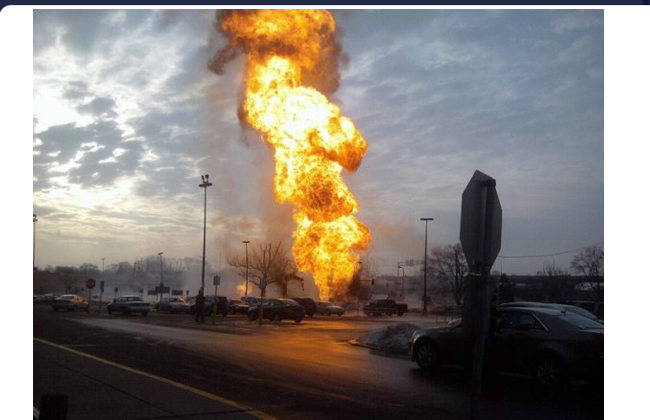




Piezoelectric Explosion in Minneapolis-St.Paul, Minnesota
by Josephine Marcotty and David Shaffer for the Star Tribune
March 18, 2011
The blazing spectacle that riveted commuters and disrupted hundreds of lives Thursday became a grinding mystery by day's end as investigators began sorting out how an underground natural gas pipeline could suddenly rupture without warning.
It didn't involve construction or someone digging in the wrong place -- it just blew.
The plume of flames erupted over 60th Street at Nicollet Avenue about 8 a.m. when gas flowing at 175 pounds of pressure through a 20-inch underground steel pipe caught fire, blowing a crater in an asphalt road. Nearby vehicles were damaged by the intense heat. No buildings were destroyed and no one was hurt.
CenterPoint spokesperson Becca Virden said the gas company was not doing any work on or near the pipe, and neither was anyone else as far as the company could determine Thursday.
State investigators have already begun what will likely be a lengthy, painstaking investigation. They will likely use CSI-like methods such as laboratory analysis of the pipe section to discover what went wrong. Corrosion, a shift in the earth, a bad weld or improper operation are just a few of the many possibilities. It may take months to get a clear answer.
One thing is certain -- such blasts are almost always memorable and often cause havoc in a neighborhood. In the last 10 years there have been 527 nationally in large gas transmission lines like the one involved in Thursday's fire. During the same time period in Minnesota there have been 30, involving both large and smaller distribution pipelines, and the rate has remained stable.
A gas explosion in San Bruno, Calif., last year killed eight people and destroyed 38 homes -- an event that shocked the nation.
The Twin Cities has seen its share of fires and explosions in the last two years, without fatalities. They include a gas explosion last September that leveled a house in Richfield. In February 2010 a sewer contractor in St. Paul struck a gas line set inside a sewer pipe, setting of an explosion in a home. Later that same month a blast in Edina took down a house on Arden Avenue after a cable TV crew accidentally severed a CenterPoint Energy gas main.
On Thursday, roadside assistance worker Emmett DySart said he smelled gas about three hours before the fire erupted. He said in an interview later Thursday that he was changing a customer's tire at 61th Street and Blaisdell Avenue and reported a "real strong smell of gas" to a CenterPoint employee. DySart, who described himself as an independent contractor for Texas-based Auto Rescue, said, "Nobody took me seriously. When I saw the fire later on, I was flabbergasted."
CenterPoint had no record of complaints about a suspicious smell of gas in the immediate hours before the fire, Virden said. Customers with complaints should first call 911, she added...
Video & Photo: Massive Explosion and Fire Rocks South Minneapolis
Twin Cities Firewire
March 17, 2011
Analysis
The unexplained natural gas main explosion in Minneapolis-St.Paul becomes comprehensible in the broader context of atmospheric resonance changes now occurring throughout our planet. The metal piping containing the pressurized flammable gas has become superheated in an energetic event that involves the focusing of nonlinear infrasound standing waves by the Orion pyramids of Giza, Egypt.
At particular resonant distances from pyramids, as in Minneapolis-St.Paul, metals become superheated by strong electrical flows transduced from ambient infrasound resonance by the pieoelectric metals themselves. In similar cases in other parts of the world, intensely electrified railroad tracks are setting off automatic roadway crossing signals, while electronic switches have been causing dozens of fatal overloads in electronic accelerator pedals in Toyota vehicles.
The case of gas pipe explosion in Minneapolis is quite similar to explosive events occurring during the same time period in Soudan Mine State Park, Minnesota (just to the north), and on the east coast of the US in Brentwood, Long Island, New York. The San Bruno, California gas main explosion, however, was apparently caused by a small cometary impact.
Minneapolis-St.Paul, Minnesota (44.97°N 93.30°W) is 6,205 miles from Giza, or 24.93%. The infrasound standing waves that become erratically focussed upton the Minneapolis area are part of a global network that can often be observed on Doppler radar as water vapor rises into the converging waves. Related events near this 25% resonant distance include the ambient levitation of large boulders in Yellowwood and Limon State Parks in Indiana. Physics laboratories located along this 25% resonant distance from Giza have reported significant variations in the atomic decay rates of various radioactive isotopes, while a special case of enhanced consciousness is also developing at this sacred distance.
This website has covered many major stories involving infrasound resonance convergence points, including Llanidloes, Mawnan, Hull, Saffron Walden, Bridlington, Goa, Klai, Auckland, Sydney, Ontario, White Rock, Ranchlands, and in the US in Newport, Anderson, Kimberley, Menomonee Falls, Pelham, Richmond, Wilmington, Nashville, Knoxville, Mobile, north Florida, Knob Noster, Denver, Seattle, Novato, Arroyo Grande and Atwater.
The cases have become so severe that spontaneous combustion of objects by piezoelectric induction has been recurring in spates - in areas such as Tenerife, Babura, Lalapansi, Mapuve, Bodibe, Landovica, Longford, Glasgow, Messina, Peschici, Berici, across northern Greece, Ratria, Kakori, Mumbai, Kishtwar, Rangrik, Kota Baru, Santo Tomas, Georgetown, La Pampa, Melipilla, and in the US in Bellvue, Colorado Springs, Pueblo, San Mateo, Vallejo, San Francisco, Santa Barbara, and New York City.